Kitten Development

At Homeward Pet, we have taken in kittens as young as 1 day old and kittens who both have and don’t have mothers that are still caring for them. When we take in kittens who are too young to be adopted, they go straight out to foster care until they are ready. This is the best way to ensure that these fragile little beings are properly socialized. Most kittens do not spend more than a week in the shelter.
Have you ever considered fostering a litter of kittens? Here is what you can expect at each of their formative weeks.
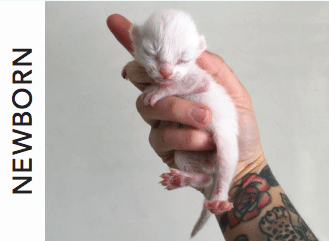 The First Week
The First Week
Newborn kittens are incredibly vulnerable. They are born blind, deaf, and unable to regulate their own body temperature or eliminate waste independently. Tiny enough to fit in the palm of your hand, they weigh just 3-5 ounces. At this stage, they are entirely reliant on their mother for protection, warmth, and nourishment. Despite their helplessness, they can purr and vocalize distress. They spend most of their time sleeping, waking primarily to eat, as they have significant growth ahead.
During their first week, kittens cannot stand. Their eyes remain closed, and their ears are folded. Orphaned kittens this young require round-the-clock care, including bottle feeding every two hours—yes, even through the night! Their senses of smell, hearing, and taste begin to develop.
By about one week of age, kittens become slightly more aware of their surroundings. Their eyes are nearly open, though their vision remains unfocused, and they have typically doubled their birth weight. Their ears also start to unfold.
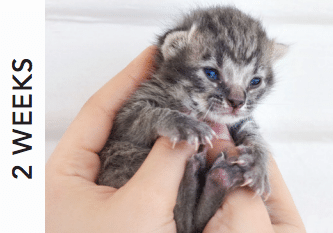 The Second Week
The Second Week
Kittens continue to grow rapidly during their second week. They huddle together for warmth and comfort, rarely straying far from their mother, their nest, or each other. Their eyes remain blue, a color that persists for the first few weeks, with their true eye color not fully apparent until around two months old. As their sense of smell develops, they may hiss at unfamiliar scents or sounds, though their tiny vocalizations are often more endearing than ferocious! They also begin kneading, though their claws are not yet retractable.
The Third Week
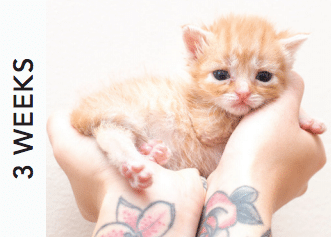 By the third week, you can often distinguish between male and female kittens. Their teeth begin to emerge, and their walking becomes more confident. This is a good time to introduce a litter box and wet food. Even at this age, kittens still sleep for a substantial portion of the day. They also start to eliminate waste independently, a significant milestone that signals the beginning of litter box training.
By the third week, you can often distinguish between male and female kittens. Their teeth begin to emerge, and their walking becomes more confident. This is a good time to introduce a litter box and wet food. Even at this age, kittens still sleep for a substantial portion of the day. They also start to eliminate waste independently, a significant milestone that signals the beginning of litter box training.
If you’re bottle-feeding, you’ll notice kittens drinking more at each feeding, but less frequently—typically four to five times a day. You can also begin introducing solid food, starting with wet food mixed with kitten formula. By the end of this week, they will weigh close to 15 ounces and walk steadily with much less wobbling.
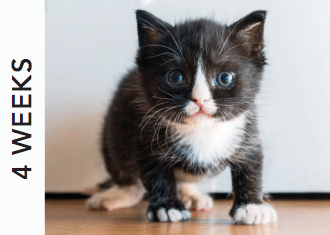 During the Second Month
During the Second Month
At four weeks old, kittens are sturdy on their feet and engage in playful interactions with each other, toys, and people. Their fur begins to fill out, and you may start to tell whether they will have short, medium, or long coats.
This is a particularly fun age! With their sight fully developed, kittens engage in vigorous and exhaustive play, running and exploring until they literally fall asleep wherever they are. While they are experimenting with solid food, most kittens still nurse from their mother (or are bottle-fed by you) a few times a day. Human interaction is crucial for kittens at this stage. Consistent handling and play from people help them associate positive experiences with humans, which is vital for their successful adoption into new homes. Kittens also begin to exhibit instinctual behaviors like stalking, hiding, pouncing, and digging—behaviors ingrained in all cats, whether they grow up indoors or outdoors.
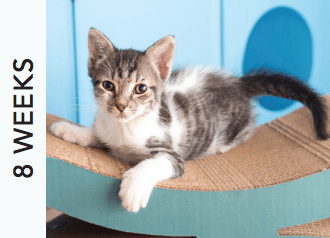 By the end of the second month, kittens will be almost fully weaned. Introducing them to new people, different areas of the home, and other pets is an important part of their socialization. At this point, they are fairly self-sufficient.
By the end of the second month, kittens will be almost fully weaned. Introducing them to new people, different areas of the home, and other pets is an important part of their socialization. At this point, they are fairly self-sufficient.
Ready for Adoption
At Homeward Pet, we have taken in kittens as young as 1 day old and kittens who both have and don’t have mothers that are still caring for them. When we take in kittens who are too young to be adopted, they go straight out to foster care until they are ready.
Considering opening your home to a litter of foster kittens? It’s a rewarding experience that makes a huge difference in their development and lives.
Not ready to foster or adopt? Please consider a donation to help us care for these fragile beings over the coming year. Make your donation recurring by clicking the tab to make it a monthly gift.
Please note that, if you are having difficulties seeing the form below, turn your browser pop up blocker off. Note that the form scrolls within itself to get to all the fields.
excerpted from a story written by Alley Cat Allies
photos courtesy of The Kitten Lady

